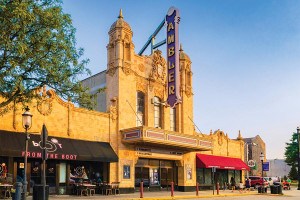Inquirer Marvels Over the MAR’s New Design
Robert A.M. Stern turned in what many considered a subpar design for the Museum of the American Revolution. The building’s cupola, especially, was a subject of consternation; called “ham-fisted” and “Disneyesque” by critics, it was just one of several mawkish, neo-historical design notes that the Philadelphia Art Commission nixed when they told Stern to try again.
And so he did, and today the Inquirer has a piece that trumpets! the! success! of the new Commission-approved design (despite the fact that, in my opinion, it’s pretty much as crappy as the old one). The article, rather than reading like journalism, reads like a press release penned by the museum itself. I don’t know why that is, but I’m aware of the fact, shall we say, that the primary backer of the museum, Gerry Lenfest, is part-owner of the Inquirer; and Lew Katz, another part-owner of the Inquirer, is also a museum board member. (Both facts are disclosed in the Inquirer’s article). These facts could be coincidental, of course. Could be.
Unfortunately, the piece does little to reassure anyone who’d be squirrelly about the question of coverage. This one begins:
They were told to make it better – Philadelphia’s Art Commission would accept no less from architects designing a proposed $150 million museum devoted to the Revolutionary War. Especially one that would stand just two blocks from Independence Hall.
So Wednesday, Robert A.M. Stern Architects delivered. And they were rewarded with unanimous approval of revised designs they had put together for the Museum of the American Revolution at Third and Chestnut Streets.
Here’s some more happy talk:
The changes that won over the commission were not minor: Architects replaced a cupola with a less-glaring, square-edged element lower on the building; reworked the front entrance on Third; and added to the facade on Chestnut a large lobby window and full-size bas-relief replica along the sidewalk of John Trumbull’s famous painting hanging in the Capitol Rotunda, The Signing of the Declaration of Independence.
Museum president and CEO Michael Quinn called the commission’s “unanimous” approval of the redesign “terrific news.”
Well, yes, Quinn would call it terrific.
“Our team did a great job of responding to them,” Quinn said in an interview after he and Stern partner Kevin Smith made presentations, and the commission approved the revised design.
“We really felt they were offering their comments in the spirit of achieving the best building for the City of Philadelphia,” Quinn said of the commission’s early feedback.
The emphasis is all on the good here. Below, a “mishmash” is nullified by a “quite well,” which is transformed into a singular triumph:
Art Commission director William J. Burke Jr. said the designers responded head-on to concerns that the original concept contained something of a “mishmash” of architectural styles. (The commission voted, 9-0, Wednesday in favor of the amended design.)
How unusual was it for a group to respond so on-point to the panel’s recommendations?
“This particular group did it quite well,” Burke said.
Here are some lines to read between:
And although one more commission vote is required, next month, to formalize the approval…
Fund-raising continues for the museum, which has received relatively little support from local foundations for fear it may cut into the business of existing museums in the city…
…[it] will be a busy year for turning the long-planned project into reality…
Such moments of clarity mitigate the off-putting tone. The Inquirer seems to let Inga Saffron, the architecture critic, do her own thing: She has written negatively about Stern’s design twice (“Revolution lite: Robert A.M. Stern’s design for the Museum of the American Revolution” in 2012, and “Changing Skyline: Stern rebuke: City tells museum architect to try again” in February). In the earlier piece, she used the phrase “gimcrack trickery” to describe the design. I’ll be interested in what she has to say about this one.
• Museum of the American Revolution gets key approval


